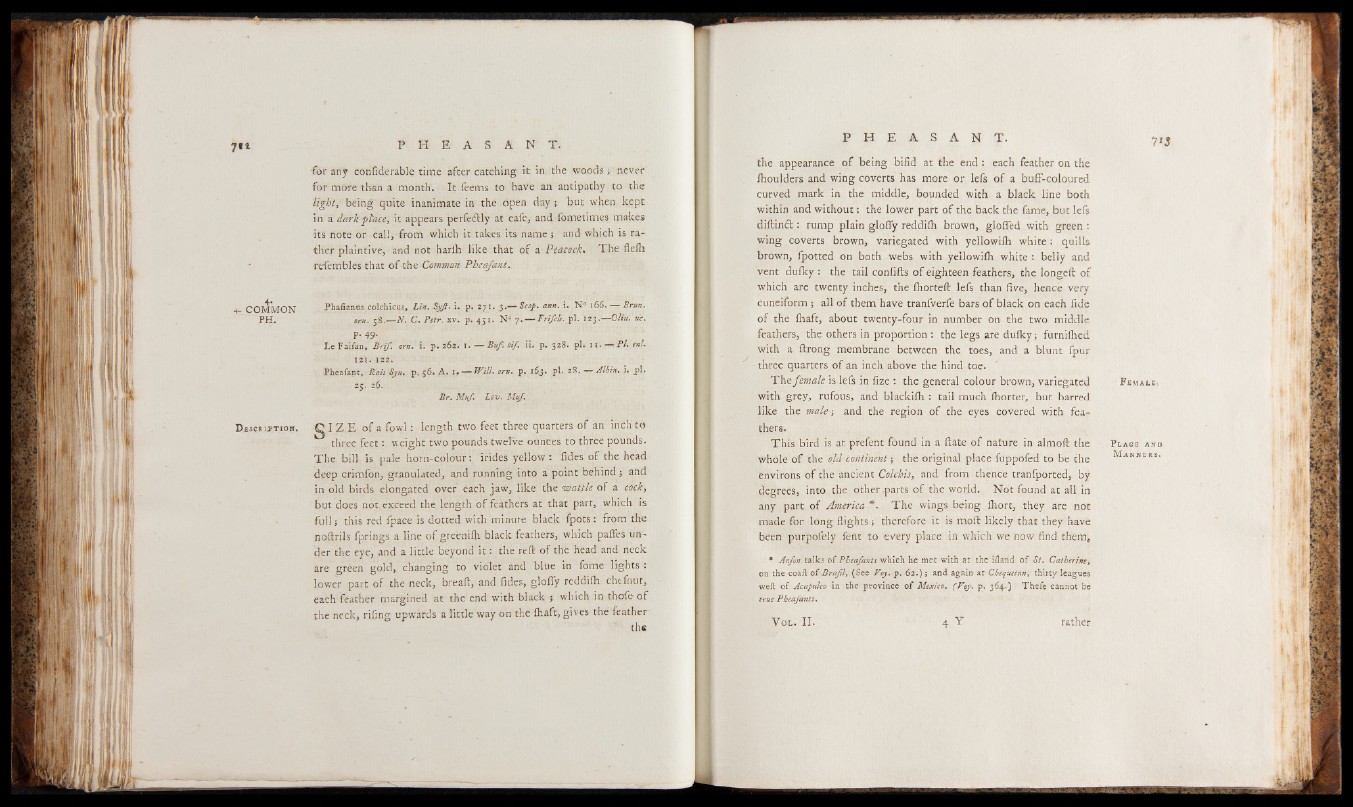
4 -
■ fc COMMON
PH.
D escriitioi«,
■ for any confiderable time after catching it in the woods ;• never
for more than a month. It feems to have an antipathy to the
light, being quite inanimate in the open day ; but when kept
in a dark place, it appears perfedHy at eafe, and fometimes makes
•its note or cal], from which it takes its name; and which is rather
plaintive, and not harlh like that of a Peacock, The flelh
refembles that of the Common Phea/ant,
Phafianas colchicus, Lin.Syß. i. p. 271. 3.— Scop. ann. i. N° 166. — Bruit,
urn. 58.— N. .C. Petr. xr. p. 451. N" 7 .— Frifcb. pi. 123.— Olitt. tic.
P- 49-
Le Faifan, Brif. orn. i. p. 262. 1. — Buß oif. ii. p. 328. pi. 11. — PL ettl..
121. -122.
Pheafant, Rail Syn. p.,j6. A. 1 .— Will. cm. p. pi. 28, — Min. i. pi.
23. 26.
Br. Muf. Lev. Mttf.
three feet: weight two pounds twelve ounces to three pounds.
The bill is pale horn-colour: irides yellow: fides of the head
deep crimfon, granulated, and running into a point behind ; and
in old birds elongated over each jaw, like thé wattle of a cock,
but does not. exceed the length of feathers at that part, which is
full; this red Ipace is dotted with minute black fpots: from the
noftrils fprings a line of greenilh black feathers, which paffes under
the eye, and a little beyond i t : the reft of the head and neck
are green gold, changing to violet and blue in fome lights :
lower part of the neck, breaft, and fides, gloffy reddifh- chefnut,
each feather margined at the end with black ; which in thofe of
the neck, rifing upwards a little way on the lhaft, gives the feather
the appearance of being bifid at the end: each feather on the
lhoulders and wing coverts has more or lefs of a buff-coloured
curved mark in the middle, bounded with a black line both
within and without: the lower part of the back the fame, but left
diftindt: rump plain gloffy reddilh brown, gloffed with green :
wing coverts brown, variegated with yellowilh white: quills
brown, ipotted on both webs with yellowilh white : belly and
vent dulky : the tail confifts of eighteen feathers, the longeft of
which are twenty inches, the lhorteft lefs than five, hence very
cuneiform ; all of them have tranfverfe bars of black on each fide
of the lhaft, about twenty-four in number on the two middle
feathers, the others in proportion : the legs are dulky; furnilhed
with a ftrong membrane between the toes, and a blunt fpur
three quarters of an inch, above the hind toe.
The female is left in fize : the general colour brown, variegated F e m a l e ,
with grey, rufous, and blackilh : tail much Ihorter, but barred
like the male--, and the region of the eyes covered with feathers.
This bird is at prefent found in a ftate of nature in alriioft the Place and
whole of the old continent; the original place fuppofed to be the Manners.
environs of the ancient Colchis, and from thence tranfported, by
degrees, into the other .parts of the world. Not found at all in
any part of America *. The wings being lhort, they are not
made for long flights j therefore it is moft likely that they have
been purpofely fent to every place in which we now find them,
* Anfon talks of Pbeafants which he met with at the ill and o f St. Catherinei
on the coaft of Brafil, (See Voy. p. 62.) j and again <l? Cbequetan, thirty leagues
weft of Acapulco in the province of Mexico, (Voy. p. 364..) Thefe cannot be
true Pbeafants.
VOL. II. 4 Y rather